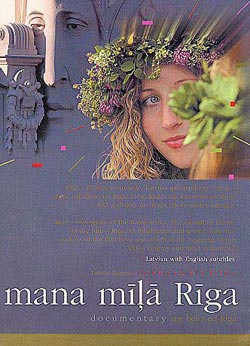
The standard tourist film about a country or city often seems to inform but at the same time lull the viewer into a gentle slumber. It’s often hard to remember the main points—and main attractions—the film has tried to bring to our attention. The problem is usually too much information in too short a time span. The documentary Mana mīļa Rīga (My Beloved Rīga) certainly does not fall into this category.
Director Laima Žurgina’s film was first released in 2004 and now is available on DVD.
The film is two hours long, so it has plenty of time to elaborate on specific themes. These give the viewer a good insight into various aspects of Rīga. There’s “Art Nouveau Rīga” and “Historical Rīga”, both with commentaries by experts; “Rīga’s Beautiful Cemeteries,” with commentary provided by a gravedigger; and the nation’s symbol , the Freedom Monument. The unhurried flow and sincerity of these commentaries, coupled with background music that blends in perfectly with each theme, make the title of the DVD seem fitting. One more added bonus is good-quality English subtitles, a detail that can often make or break a product.
Other clips show Rīga’s unique and memorable celebrations such as the seasonal Zāļu tirgus (herb and grass market) in the Dome Square the day before Midsummer Night and the annual arts and crafts fair at the Open-air Ethnographic Museum just outside Rīga during the first weekend in June. These two occasions show the nation’s love for tradition, both in terms of celebrating specific festivities as well as the continuation of centuries’ old traditions of embroidery, knitting, weaving, ceramics and other local handicrafts.The hope is that these folkloric legacies will remain with the Latvians for decades to come and cosmopolitanism will not take over.
Interviews with the architects of the new Hansabanka building, Saules akmens, as well as the architect responsible for the total revamp of Rīga Airport show Rīga’s contemporary new face and the direction that Rīga is heading in the 21st century. A fairly lengthy section devoted to a street festival may seem to drag, but it does show Rīgans relaxing and is a welcome break from the more serious parts of this documentary.
Scenes depict famous Rīga-born celebrities such as Gidon Kremer and the Kremerata Baltica, Olympic javelin-thrower Jānis Lūsis and his son Voldemārs, and artist Kristaps Zariņš—all in some way expressing their pride in their hometown and the emotional ties that bind them to the place. A Russian Orthodox Easter Mass, the opening ceremony of the Jewish Ghettos Memorial in Rumbula, the Latvian Song Festival and enthusiastic hockey fans celebrating Latvia’s win in a game all effectively depict the multicultural microcosm that is Rīga.
You catch the feeling that Rīga is in a state of flux. The film has no pompous attempt to exaggerate Rīga’s attractions nor an undertone of apologising for its shabbiness and neglect as a result of Latvia’s Soviet legacy. Emphasis is on the future, on Rīga’s dynamic changing nature and the possibilities that lie ahead.
After seeing this documentary you feel intrigued by Rīga and its diversity. The fim provides just enough information to raise a potential tourist’s interest level. For those who have just been to Rīga the film will give a bit more of an insight into what makes this city tick. The cinematography also helps shape the film. Subtle changes to the standard format—architecture, history, nature shots—couple with unusual angles, the use of narrative by local experts and a general feeling that the film has not been merely commissioned but created by professionals with a strong sense of pride in their city, make Mana mīļa Rīga stand out from other films of this genre. Rīga, and Latvia in general, would benefit if more people would use their creative skills with this positive aim in mind.
Details
Mana mīļā Rīga
Laima Žurgina
VISIO Ltd., 2004
Notes: In Latvian with English subtitles. Documentary, 116 minutes. Script: Laima Žurgina; camer: Edgars Bite, Gvīdo Skulte and Uģis Egle; sound director: Aivars Znotiņš; producers: Laima Žurgina and Dzintars Belogrudovs.
Where to buy
Purchase Mana mīļā Rīga from BalticShop.
Note: Latvians Online receives a commission on purchases.
© 1995-2024 Latvians Online
Please contact us for editorial queries, or for permission to republish material. Disclaimer: The content of Web sites to which Latvians Online provides links does not necessarily reflect the opinion of Latvians Online, its staff or its sponsors.




